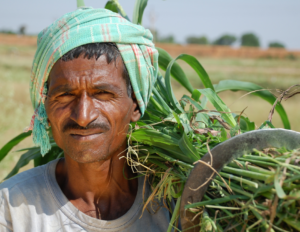GS III-AGRICULTURE

Background & Context
- The PM-KISAN scheme, operational since December 1, 2018, is aimed at providing financial assistance to small and marginal farmers.
- Recently, concerns over alleged corruption in its implementation have been raised, particularly by the Tamil Nadu Cauvery Farmers’ Protection Association.
- The Government of India (GOI) reinstated 34 lakh farmers under the “saturation drive” after noticing a 20% drop in beneficiaries.
Nodal Ministry
- Ministry of Agriculture & Farmers’ Welfare oversees the scheme.
Objectives of PM-KISAN
- Financial Support for Farmers: Helps in acquiring inputs for improved crop production.
- Prevention of Debt Trap: Aims to protect farmers from falling into moneylenders’ debt cycle.
- Boosting Rural Demand: Encourages higher consumption in rural areas.
- Doubling Farmers’ Income: Aligns with GOI’s target to double farmers’ income by 2022.
Key Features of the Scheme
- Income Assistance
- Eligible farmers receive ₹6,000 per year, disbursed in three equal instalments every four months.
- Initially, the scheme covered only small and marginal farmers (SMFs) with landholding up to 2 hectares, but was later expanded to all farmers, regardless of land size.
- Flexibility in Usage
- No restrictions on how farmers utilize the financial assistance provided under the scheme.
- Funding
- Fully funded by the central government.
- Initially allocated ₹75,000 crore annually, with funds transferred directly to beneficiaries’ bank accounts through DBT (Direct Benefit Transfer).
- Beneficiary Identification
- State and UT governments are responsible for identifying eligible farmers.
- Definition of Family: Includes a husband, wife, and minor children.
Exclusions: Who is NOT Eligible?
Certain categories of individuals are excluded from availing benefits:
- Institutional Landholders
- Elected Representatives (Current & Former)
- Holders of constitutional positions
- Ministers, MPs, MLAs, MLCs, Mayors, and District Panchayat Chairpersons
- Government Employees
- Serving & retired State/Central government officials, PSU employees, and local body staff
- Higher Income Groups
- Pensioners receiving ₹10,000+ per month (excluding Class IV/MTS employees)
- Individuals who paid income tax in the last financial year
- Professionals (Practicing lawyers, doctors, engineers, architects, and CAs)
Performance & Significance of PM-KISAN
Positive Impact
- Direct Cash Transfer ensures quick and transparent disbursal of funds.
- Digital Records facilitate easy tracking & registration of farmers.
- Equitable Distribution: No bias in beneficiary selection.
- Agricultural Modernization: Supports GOI’s push for agricultural reform.
- Research Findings (IFPRI Study):
- Helps farmers overcome liquidity constraints.
- Encourages adoption of modern crop varieties through Krishi Vigyan Kendras.
- Strengthens farmers’ financial capacity & investment in agriculture (e.g., seeds, fertilizers, equipment).
- Boosts rural economic growth.
Criticism & Challenges
- Exclusion of Eligible Farmers
- Not all intended beneficiaries receive the benefits.
- Only 21% of surveyed cultivators confirmed receiving funds.
- Exclusion rates were higher in Uttar Pradesh than in Haryana & Rajasthan.
- Not Inclusive of All Agricultural Workers
- Landless farmers & tenant cultivators do not qualify for the scheme.
- Cash Transfers Not Indexed to Inflation
- Due to regional price fluctuations, cash assistance loses purchasing power over time.
- Example: Failure of DBT in Rajasthan where transferred funds couldn’t cover rising kerosene prices.
- Operational & Administrative Challenges
- Land records reconciliation & digitization remain slow.
- Northeastern states face difficulty in identifying beneficiaries due to community-based land ownership.
- High administrative costs put pressure on state finances.
PM-KISAN Mobile App
- Developed by NIC in collaboration with MeitY.
- Enables farmers to:
- Check application status.
- Update Aadhaar details.
- Track fund disbursals to their bank accounts.
Similar State-Specific Schemes
- Bhavantar Bhugtan Yojana (Madhya Pradesh)
- Covers the gap between MSP (Minimum Support Price) and actual market prices.
- Rythu Bandhu Scheme (Telangana)
- Provides ₹4,000 per acre per season to all farmers.
- KALIA Scheme (Odisha)
- Offers ₹5,000 per season (₹10,000 annually) to small & marginal farmers.
- More complex in implementation than PM-KISAN.




